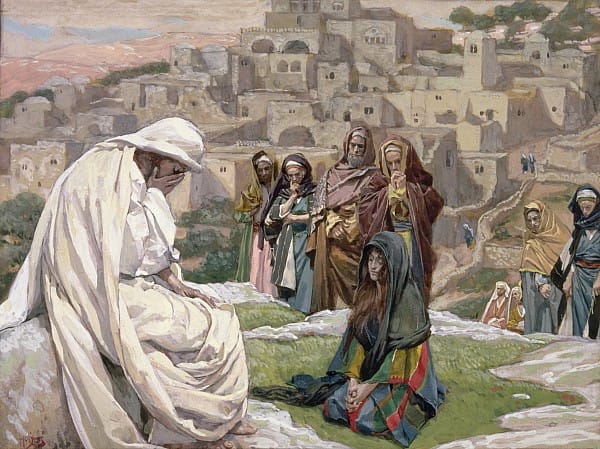アヴェ・マリア・インマクラータ!
愛する兄弟姉妹の皆様、
今日は聖母の聖名の祝日ですね!
以前、トリエント公会議による公教要理の「主祷文」について
第12章 主祷文 天に在す我らの父よ
第1の願い「願わくは御名の尊まれんことを」
また
第2の願い「御国の来たらんことを」
は、既にご紹介いたしました。
今日は、聖母の聖名をたたえて、
第3の願い「御旨の天に行われる如く、地にもおこなわれんことを」
についての箇所の説明(本邦初の日本語訳)をご紹介します。
天主様の祝福が豊かにありますように!
トマス小野田圭志神父(聖ピオ十世会司祭)
第3の願い「御旨の天に行われる如く、地にもおこなわれんことを」
82. 主キリストが「主よ、主よと言う者が皆天の御国に入るのではない。却って天におられる私の父の御旨を果たす者こそが、天の御国に入るのである1」と仰せられたため、当の天の御国に入ることを望む者は皆、天主の御旨が果たされるよう祈り求めねばなりません。この第3の願いが天の御国の祈願のすぐ後に置かれるのは、まさにこのためです。
83. この祈願をとおして天主に願うことが私たちにとっていかに必要であり、かつ数多(あまた)の貴い賜をもたらすものであるかを信徒がよりよく理解するために、司牧者は、人祖の罪のために人類がどれほど大きな災厄と苦難とに打ちひしがれていたかを示すべきです。
1 マタイ 7章21節
§1. 人類の惨苦とその原因
84. 天主は始めに、各々の被造物が自らに固有の善を希求するよう図られました。すなわち一種の自然的傾向によって自らの目的を追求し、外部からの妨げを受けぬかぎり、常にこれに達するようにされたのです。しかるに始原より、人間におけるかかる自然的傾向は、己が至福の源かつ与え主である天主を希求する類のものであり、この性向は人間が理性と判断力とを有するものであるがゆえに、一層卓越し、異彩を放つものでした。
85. しかるに理性を欠く他の諸々の被造物が自らに自然的に属する傾向を保ち、原初に良きものとして創られたごとく、その同じ状態、有様とに今日に至るまで留まってきたのに反し、あわれな人類は自らのたどるべき道から逸(そ)れてしまいました。すなわち始原(はじめ)の正義の状態に伴う諸々の利善一これらの善をとおして天主は人祖を固有の本性を越える仕方で強め、飾られたのでしたがーを失ったのみならず、内心に刻まれた、美徳に対する熱意を甚だ弱めてしまいました。詩編作家の述べるとおり、「皆が道から逸れてしまった。彼らは一様に無用の物と化し、善を為す者は誰一人としていない2」 ようになってしまったのです。
86. 事実、人の心と,思いとは、その若き日から悪へと向かうものであり、したがって、誰も自力で己が救霊に導き得るようなことを,思いなすことさえできず、却って皆が悪への傾きを有し、また人の悪しき欲情は枚挙のいとまもなく、怒り、憎しみ、倣慢、野心ならびにおよそありとあらゆる悪徳に人が容易にかつ性急に流されてしまうことも驚くに足りません。
87. これらの害悪に、いわば浸かりながら私たちの生活は営まれるのですが、人類の最たる不幸は、当の諸悪は往々にして、我々の目に少しも悪いものとは映らないという事実です。諸々の情欲に目をくらまされ、自らにとって益となると思われる事物がしばしば害毒に満ちたものであるということを看取せず、却って当の害悪に、あたかも甚だ望ましく、追い求めるに値する善益であるかの如く飛びつき、反対に真の善、真の美徳は、好ましくないものの如くこれに背を向けるという有様は、人類の窮状を何よりも雄弁に物語っています。
88.かかる謬見(びゅうけん)および誤った判断をきらって天主は「悪を善と呼び、善を悪と呼ぶ者、闇を光と見なし、光を闇と見なす者、苦き物を甘き物と見なし、甘き物を苦き物と見なす者に呪いあれ3」と仰せられています。
89. かくして我々人間の惨状を如実に示すべく、聖書は私たちを正しい味覚を失い、健康によい食物を嫌って、これを害する食物を求める者らになぞらえています。加えて聖書は、私たちを病を癒されないかぎり、健康な常人の職務を果たし得ない病人にもたとえます。同様に私たちは、天主の聖寵の助けによらずには天主に嘉(よみ)される行ないを執り行うことはできないのです。
90. このような状態で何某(なにがし)かの善を為すなら、当の善はおよそ取るに足らぬものであり、天の永福を得るために全くあるいはほとんど役に立ちません。しかるに天主をしかるべく愛し崇め奉ることは、いわば地べたに這(は)いつくばっている私たちの自力で為すことは遠く及ばず、天主の恩寵の助力によって助け起こされぬかぎり、断じてこの高遠なる境地に至ることはできません。人類の哀れな窮状を示すために、 我々人間を、自らの裁量に任されると、万事に見境なく飛びついてしまう子供にたとえることも、しごく適当です。実に私たちは(悪い意味で)子供であり、知慮に欠ける者です。したがって、事実、天主の助力がなければ、私たちはつまらない会話に時を過ごし、無益な行いに耽るものだからです。さればこそ「天主の」知恵は私たちを答めて言うのです。「小さな子らよ、いつまで児戯(じぎ)を選り好むのか。いつまで愚か者は己(おのれ)を害するものを求めるのか4」また使徒パウロも、「分別において子供の如く成るべからず5」、と諭(さと)しています。
91. しかるに私たちは、年若き者よりもさらに浅はかで知慮に欠く者であると言わなければなりません。と言うのは、年少の者はたとえ今は人間的賢慮に欠くとしても、時と共にこれを得ることができるからであり、一方、救霊に欠くべからざる神的賢慮については、天主がこれを求める心を私たちの中に育み、保ってくださらぬかぎり、これを望むことすらできないからです。事実、もし天主が助力を施してくださらないならば、私たちは真に善きものをことごとく打ち捨てて、自らの滅びに進んで身を投じるのが必定です。
92. しかるに、もし天主の御光(みひかり)によって心の闇を退け、人類のかくも哀れな境遇を直視し、精神の鈍磨の陰に妨げられることなく肢体の法と、感覚の欲情が霊に反して起こす争いとを自らの中に認め、人間本性の悪に対する傾きを考慮するならば、誰が(原罪によって)傷つけられた本性のゆえに被るかくも大きな悪に対する適切な救済を切に乞い願い、キリスト教徒の生活の導きかつ鑑(かがみ)となる、この上なく有益な規範を求めないでしょうか。
2 詩編 118
3 イザヤ 5章20節
4 箴言(しんげん)の書 1章22節
5 コリント人への前の手紙 14章20節
§2. 「御旨の行われんことを」、という祈願をとおして、私たちはかかる惨苦からの救済を祈り求めるのであること
93. しかるに、まさにこれこそ、「御旨の行(おこな)われんことを」と述べて、私たちが天主に祈り求めるところのものに他なりません。私たち人間が、先に述べたような災厄に見舞われるようになったのは、天主に対する従順を破り、その御旨を軽んじたためです。したがって、かくも多くの悪6に対して天主が私たちにお示しになった唯一の救済策は、罪を犯すことをとおして軽んじたところの天主の御旨に従って生き、私たちの全ての,思いと行いとを、この規範に合わせることに他なりません。そしてこの恵みを得ることができるよう、「御旨の行われんことを」と唱えて天主に求めるのです。
94. しかるに当の祈願は、すでに天主がその霊魂の中に統治され、神的光の輝きによって照らされ、かかる恩寵により、天主の御旨に従って生きるところの者によってもなされるべきです。と言うのも、私たちがこのような善い心構えを有しているとしても、地上に生きる中は、人間の感覚に内在する悪に対する傾きのために、自らの欲情と戦わねばならず、したがって、肢体に宿る欲情に引きつけられ、これにおし流されて、救いの道から逸れてしまう大きな危険を私たち自身の中に有しているからです。
主キリストも、「誘惑に陥(おちい)らないように目覚めて祈れ。心は熱しても肉体は弱いものだ7」と仰せられて、かかる危険に注意するよう促しておられます。
95. 事実、肉体の欲求を、これが決して(理性に反した仕方で)かき立てられることがないほどに従い馴らすということは人間のーたとえそれが義化された者であれ一力の及ぶところではありません。なぜなら義化された者らにおいて、天主の恩寵はたしかにその霊魂を癒すのですが、使徒パウロが、「私の中に、すなわち私の肉に善が住んでいないことを私は知っている8」と述べて示しているように、その肉体をも癒すものではありません。
96. 人祖が、それによってあたかも轡(くつわ)のように種々の欲情が抑えられていたところの原初の正義を失うやいなや、理性はもはや当の欲情をその正しい領域に留め、理性に反するものを望むことのないように制御することが全くできなくなってしまいました。使徒パウロが 「罪」、すなわち罪の源ないしは温床とも言うべきものが、人間のこの肉体という部分に巣くう旨を著していますが、それは、かかる罪に対する傾きが、いわば来客のように一時的に私たちの中に留まるのではなく、却って私たちの肉体の住人の如く、肢体という住居の中にずっと住み着くものであることを示すために他なりません。
したがって、己(おの)が中に潜(ひそ)む内的な敵にたえず攻め立てられる私たちは、天主の助力に寄りすがり、私たちの中にその御旨が行われるよう祈るべきであることを容易に悟ります。
6 訳者注:道徳的、ならびに物質的な意味での悪。
7 マタイ 26章41節
8 ローマ人への手紙 7章18節
§3. 天主の御旨とは何であるか
97. しかるに、信徒が「天主の御旨」という言葉の意味を正しく理解するよう図らねばなりませんが、スコラ学者たちがこの点に関して為す有益かつ豊富な議論の大部分を省略して、ここで言う「天主の御旨」が、天主の「表示的意志9」と呼ばれるところのもの、すなわち私たちが為す、あるいは避けることを天主がお命じに、もしくはお勧めになった事柄を指すものである旨述べるにとどめます。
98. したがって、ここで言う「御旨」とは、私たちが天の至福をかち得るための手段として天主が私たちに提示される一切のものーそれが信仰に関するもの、あるいは道徳に関するものであれーを含みます。またこれは、主キリストがおん自ら、ないしはご自分の教会をとおして私たちが為す、あるいは避けることをお命じになった全てのことを含みますが、それは使徒パウロが「あなたたちは、思慮のない者とならず、主の御旨を理解せよ10」と述べて指していることに他なりません。
99. したがって、「御旨の行われんことを」と祈るとき、私たちは殊に、天の御父が私たちに、主のご命令によく従い、また聖性と正義の中に日々たゆまず主にお仕えする恵み11を給わるよう願うのです。
すなわち、全てを天主の御旨とお望みにしたがって為し、聖書中に示される種々の義務をしかるべく果たし、かつ「肉体の意志ではなく、天主によって生まれた12」者たちにふさわしいことの一切を、「死に至るまで、しかも十字架の死に至るまで従う者となられた」主キリストの例に倣い、天主の導きと助力とによって成し遂げることができるよう、そしてその御旨からたとえ少しでも逸(そ)れるよりは、あらゆる艱難を耐え忍ぶ心構えをもつことができるよう祈り求めるのです。
100. しかるに、天主に従う者らが帯びる、この上ない尊厳を見てとる者こそ、誰にもまして、この祈願に対する愛と熱意とに燃えることとなります。当の者は、「天主に仕え従うことは、統治することである」という言葉が、いかに当を得たものであるかを悟るからです。実に主は、「天におられる我が御父の御旨を果たす者は皆、我が兄弟、姉妹、母である」と仰せになって、かのような者に、愛と仁慈の絆によって、この上なく緊密に結ばれておられることを示されました。
101. 聖なる者の中で、当の祈願の対象となっているものを、ことさら熱心に天主に祈り求めなかった者は、一人としていません。この恵みを得るために、彼らは美しく多様な表現を用いてきわめて頻繁に祈ったのですが、その中でもダビドの変化に富んだ祈りの言葉は、殊に味わい深いものです。
ある時は、「御身の定めを守らんがために、我が道を導き給え」と、またある時は、「御掟(みおきて)の道に我を導き給え」と祈り、かと言うと時には、「我が歩みを御言葉(みことば)によって律し給え、いかなる不義も我を圧することなきように13」「御言葉によって私の足取りを固め、いかなる不義をも我に打ち勝たせ給うな」、と叫び、また同様の心境で、「[主よ、]御掟(みおきて)を守らんがために、我に理解を与え給え。御裁きを我に教え給え。御証(みあかし)を悟らんがために理解を与え給え。」と祈っていますが、この同じ,思いを言葉を換えて繰り返し、言い表しています。しかるに司牧者は、この祈願の第一の部分が含む霊的な諸善がいかに大きなものであるかを皆が理解するように、信徒の注意をこれらの章句に向け、かつこれを入念に解説しなければなりません。
102. 第二に、「御旨の行われんことを」というこの祈りをなす際、私たちは必定、「肉の業」を忌み嫌うことになりますが、当の肉の業については、使徒パウロの次の言葉が思い起こされます。「肉の業は明白である。すなわち、淫行、不浄、猥褻(わいせつ)、偶像崇拝、魔術、憎み、争い、嫉妬、憤り、徒党、分離、異端、そねみ、泥酔、遊蕩、ならびにそれに似たことである。14」また、「もしあなたたちが肉にしたがって生きるなら、あなたたちは死に定められている15」したがって、私たちは天主に、感覚、欲情、ならびに(自然本性)の弱さが求めることを果たすことなく、却って天主の御旨によって私たちの意志が律されるよう願うのです。
103. しかるに地上的事物に関する配慮と,思念とに没頭する、欲得の者たちは、この天主の御旨からおよそ遠く隔たっています。なぜならかかる者たちは、欲望に駆られて、自らの欲求するものを得るために遭進(まいしん)し、かかる不徳な欲情を満たすことに幸福を見出すのです。彼らにとって、何でも望むものを手に入れる者こそが幸いな者なのです。
しかるに私たちは、使徒パウロが述べるように、「肉の望みを満たすよう心を傾ける16」ことなく、却ってその御旨を果たすことができるよう、天主に願うのです。
104. とは言え私たちが自らの欲情が満たされることのないよう天主に祈るのは、さほど容易なことではありません。なぜなら、このように祈る私たちは、あたかも自らを忌み嫌う者の呈を成し、他方、自分の肉体にのみ固執する者たちは、これを愚の極みだと見なすからです。
しかるに私たちは、「もし私のあとに従おうと思うなら、己を捨てよ17」と命じられたキリストのために愚か者と見なされることを、喜んで甘んじ受けるべきです。
105. 実際、正しく道理に適ったものを望むことは、理性、美徳、天主の法に悖(もと)るものを得ることよりも遥かに優ります。したがって、欲情に駆られてやみくもに望んでいたものを得る者は、願っていた善きものを得ない者より、遥かに哀れな者です。
このようなわけで、私たちは、自分たちの我意から望むことを私たちにお与えにならないよう天主に願うにとどまらずーなぜなら私たちの願望は往々にして悪いものだからです一、さらには、私たちが時として、光の天使に化けた悪魔の霊感、ほのめかしにつられて、何か善いものとして天主に願うものも、私たちにお与えにならないよう天主に祈ります。
使徒の長ペトロが、主を死に至る道程から引き戻そうとした際、彼の熱意は甚だ正当で、敬虔に満ちたものであるように思われました。しかるに、天主の理(ことわり)ではなく、あくまで人間的な感情によって動かされていたため、主の厳しいお咎めを受けたのです。また、聖ヤコボと聖ヨハネが、主をお迎えするのを拒んだサマリア人らの上に火の雨を天から降らせ、この頑(かたく)なで非情な民を殲滅(せんめつ)されるよう、義憤に駆られて乞うた時も、主に対するこの上なく深い敬愛の念に促されてのことではなかったでしょうか。しかるに彼らも、「あなたたちは、自分がいかなる霊にしたがっているかを知らない。人の子は、霊魂を亡ぼすためではなく、救うために来たのである18]、と主からたしなめられたのです。
しかるに、天主に、その御旨が果たされることを祈るのは、唯私たち自身の望みが悪いものであるとき、あるいは悪いものであるように思われるときのみならず、悪くないものを望んでいるとき、例えば私たちの意志が人間本性の自然な傾きにしたがって、生命の維持につながることを求め、かつこれに反するものを拒絶する際にも、同様に天主の御旨が行われるよう祈り求めねばなりません。したがって、もし私たちがこの種のことがらを願うべきであると思われる状況に置かれた場合、「その時こそ、」心から「御旨の行われんことを!」と申し上げて、救いと、救いに至るために必要なことに関する知識とを私たちにお与えになった主の例に倣うこととしましょう。なぜなら主は、数多の苦難と織烈を極める死に対する自然な恐れに動揺された際、この上ない苦痛に対する恐れの只中にありつつも、「私の意志ではなく、御身のご意志こそが果たされんことを19」と祈って、ご自分の意志を御父の御旨に従わされたのです。
106. しかるに、人の心はかくも(原罪によって)傷つけられたものであるため、一旦自分の欲求を抑え、これを天主の御旨に従わせたとしても、私たちを悪から守り、善へと導いてくださる天主の御助けなしには、罪を避けることはできないのです。
そのため、この祈りを唱えて、私たちの中にお始めになったことを、完遂してくださるよう、欲情の突発的な動きを抑えてくださるよう、私たちの欲求が理性にしたがうものとなるよう、ならびに私たちをことごとく御旨にそわせてくださるよう、天主に乞い求めねばなりません。さらに、全地が天主の御旨を知るにいたり、かくして世々に隠されてきた天主の奥義が、万人に明かされ、知れわたるよう祈らねばなりません。
9 原語ラテン語では "Voluntas signi"。仏語では "Volonté de signe" と訳される。
10 エフェゾ人への手紙 5章17節
11 ルカ 1章75節参照
12 ヨハネ 1章13節
13 詩編 118
14 ガラツィア人への手紙 5章19節
15 ローマ人への手紙 8章13節
16 ローマ人への手紙 13章14節
17 マタイ 16章24節
18 ルカ 9章55節
19 ルカ 22章42節
§4.天における如く地にも行われんことを
107. 加えて、天主の御旨に、ふさわしい仕方でしたがう恵みを願うことが必要です。すなわち、至福の天使ら、および天に在る全ての霊魂が天主の御旨に、すすんで大きな喜びをもって従うのに倣って、私たちも同様に、天主がお望みになる仕方で、喜び勇んで従うことができるよう祈るのです。実に天主は、私たちが主に対して抱く熱意、またそのために為す所業において、この上なく深い敬愛の念と、際立った愛徳の心とをお求めになるのです。かくして私たちは、たとえ天における報いを得る望みをもって、天主に私たちの身をことごとくお捧げするものであるにせよ、それはあくまで天主が、私たちが当の報いを望むことを嘉(よ)しとされたかぎりにおいてこれを望むことととなります。したがって、私たちの希望はことごとく、天主に対する愛に基づくものでなければなりません。当の天主は、私たちがご自身に対して抱く愛に、永遠の至福という報いをお定めになったからです。
108. つきつめると、報償のために、主人に愛着して仕える者らがおり、彼らにおいては、主人よりも、その報いを愛好するものであると言わねばなりません。しかるに他の者は、報いをお与えになる方20に対する愛と敬虔の念とに動かされて、これに仕えます。彼らは、当のお方の仁愛と美徳とにのみ目を向け、それを認め、嘆賞するがゆえに、これにご奉仕できることを無上の幸いと見なすのです。この意味でこそ、「天における如く地にも(行われんことを)」という言葉が加えられているのです。
109. なぜなら私たちは、ダビドが次のように歌ってその秀でた従順を讃(うた)える至福の者たちの例に倣って、天主に従うよう全力を尽くすべきだからです。「天の万軍よ、主を祝せよ、御旨を行う僕(しもべ)たちよ21」
110. もし聖チプリアノの解釈にしたがって、「天における」という言葉を「善良で敬虔な者たちにおいて」という意味に、また「地にも」という言葉を「邪で不敬な者らにおいても」という意味に解する人がいるとすれば、私たちはこの見解をもよしとします。また同聖人の為すもうーつの解釈、すなわち 「天」は「霊」を、「地」は「肉」を指すという解釈も正当なものです22。 この見方にしたがえば、「御旨の天に行われる如く、地にも行われんことを」と唱えることをとおして、万人、万物が全てにおいて天主に従うものとなるよう祈ることになります。
111. 当の祈願はまた、「感謝の祈り」をも含んでいます。なぜなら、「御旨の天に行われる如く、地にも行われんことを」と祈ることによって、私たちは天主の至聖なる御旨を敬い、かつその一切の御業をこの上ない喜びに駆られ、無上の賛美と感謝の念をもって讃えることとなるからです。事実、私たちは天主が全てを良く為されたことを確知しています。なぜなら、天主が全能であることに疑念の余地はないため、したがって、必然全てはそのご意志によって造り成されたこととなります。他方、私たちは天主が究極の善であると断言するためーこれは全く真実のことですが一、その御業には良いものしか見出されないことを、私たちは讃えて言わねばなりません。天主は、一切のものにご自分の善性をお分かちになったからです23。
112. そして、たとえ私たちが万事において天主の道理24を見極め得ず、却って「私たちの弱い知性にとっての」明白さが欠けることがあるとしても、いささかのためらいもなく、「天主の道は、測(はか)り難い25」旨、公言しなければなりません。
私たちが天主の御旨を尊ぶのは、天主が私たちをして、天的な光で照らしてくださったためでもあります。実に、「天主は私たちを闇の権力から救い出し、愛する御子の国に移された26」からです。
113. しかるに、当の祈願の考察を終えるに当たって、この章の冒頭で述べた点に再び立ち帰る必要があります。すなわち、信徒がこの祈りを唱える際、自らの自然本性に根ざし、天主の御旨に逆らう数多(あまた)の欲情の勢いを省み、同時に自分が、「凡(すべ)てのものは御身に従う27」という詩編の章句の述べるように、「天主の御旨に対する従順において」一切の被造物に劣っていること、また天主の助力によらなければ、これに嘉(よ)みされる業を何一つ成し遂げることはもちろん、始めることさえできないほど脆弱(ぜいじやく)な者であることを想い起こし、深い恐縮と謙遜の念をもってこの祈りを唱えるべきだということです。
114. しかるに、上述したとおり、天主に仕え、その法と掟とに従って生きることほど気高く、優れたことはないため、キリスト教徒にとって、主の道を歩み、かつ天主の御旨に背くことを何一つ心に抱かず、行わぬことほど望ましいことはありません。
115. しかるに、このように天主の御旨にしたがって生き、またそのために必要な恵みを謙った心で願う習慣を培い、保つために、信徒は聖書をひもといて、自らの企図の主眼を天主の御旨に合わせなかったために、すべてが裏目に出た者たちの例を見てとるべきです28。
116. 自らが値するところよりも低い地位に置かれていると思う者は、己が境遇を平静な心で受け容れ、自らの身分を捨てず、却って天主に召された境遇に留まる29べきです。そして私たち自身よりも、はるかに私たちのために慮られる天主の尊い御旨に自らの判断を服従させることが肝要です。
もし私たちが貧困、病苦、迫害およびその他の災厄、艱難(かんなん)に打ちひしがれるならば、これらのこと一切は、万事の究極の理由である天主の御旨によるのでなければ、私たちの身に降りかかることが決してない、と確信しなければなりません。そうして、当の苦難に過度に動揺することなく、却って「主の御旨の果たされんことを」、あるいは聖ヨブに倣い、「主の由とされた如く、かくして「我が身に」起こりしなりき。主の御名の祝されんことを30」といつも言って、雄々しくこれを耐え忍ぶことにしましょう。
20 訳者注:すなわち天主のこと。
21 詩編 102篇21節
22 訳者注:すなわち聖パウロがその書簡においてこれらの語を用いるような意味において。
23 訳者注:無論、天主がご自分の善性を被造物に「お分かちになる」際、当の善性が減じるものでない。
24 訳者注:すなわち天主がなぜこれこれのことが起こるのをお許しになるか。
25 ローマ人への手紙 11章33節
26 コロサイ人への手紙 1章13節
27 詩編 118篇91節
28 訳者注:例えば畑を得った代金の一部をかくし取ったアナニアとその妻サフィラの欺瞞(使徒行録)、掟に背き司祭に代わって犠牲を捧げたサウロ王(サムエルの書上13章)の例などが挙げられる。又両者共に、天主の罰として、あわれな最期を遂げることになる。
29 コリント人への前の手紙 7章20節
30 ヨブの書 1章21節 5章
![]() Photo credit
Photo credit



















 アヴェ・マリア・インマクラータ愛する兄弟姉妹の皆様、大阪の夕方の主日のミサについてご質問を受けました。【質問】童貞聖マリア様の御誕生の大祝日おめでとうございます!......
アヴェ・マリア・インマクラータ愛する兄弟姉妹の皆様、大阪の夕方の主日のミサについてご質問を受けました。【質問】童貞聖マリア様の御誕生の大祝日おめでとうございます!...... アヴェ・マリア・インマクラータ!愛する兄弟姉妹の皆様、、台風21号は、大阪に大きな被害をもたらしました。聖ピオ十世会の聖堂は、被害が無かったとの報告を受けております。......
アヴェ・マリア・インマクラータ!愛する兄弟姉妹の皆様、、台風21号は、大阪に大きな被害をもたらしました。聖ピオ十世会の聖堂は、被害が無かったとの報告を受けております。...... アヴェ・マリア・インマクラータ!愛する兄弟姉妹の皆様、今日は聖母の御誕生日です。おめでとうございます!ルルドさんというハンドルネームの方からコメントを頂きました。ル......
アヴェ・マリア・インマクラータ!愛する兄弟姉妹の皆様、今日は聖母の御誕生日です。おめでとうございます!ルルドさんというハンドルネームの方からコメントを頂きました。ル......
 、「イエズス様の聖心が、涙を流して泣いている」という姿を想像して下さい。秋田のマリア様の御像は、涙は流されました。ラ・サレットの聖母も涙されました。今日、ファチマのマリア様も涙を流していると想像してみて下さい。こんなに私たちを愛しているにも関わらず、霊魂がその愛に応えないその様子を見て、流している涙です。
、「イエズス様の聖心が、涙を流して泣いている」という姿を想像して下さい。秋田のマリア様の御像は、涙は流されました。ラ・サレットの聖母も涙されました。今日、ファチマのマリア様も涙を流していると想像してみて下さい。こんなに私たちを愛しているにも関わらず、霊魂がその愛に応えないその様子を見て、流している涙です。





